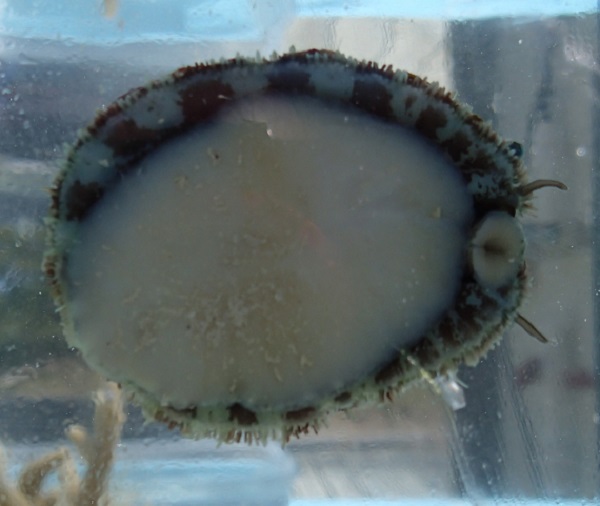Anatomy & Physiology
The shell of Haliotis ovina has been described in more detail in the 'Physical Description' section of this web page. Abalone shells have evolved to allow the ingress of a ventilating water current to pass across the gills and to exit through the posterior holes (tremata) in the shell. The abalone's anus and kidneys also lie beneath the tremata which are also used for excretion (Ruppert et al., 2004).
The two bipectinate gills, the kidney and reproductive and digestive organs are located posteriorly within the shell dorsal to the muscular foot which gives gastropods their name (Ruppert et al., 2004).
 Diagram of the internal anatomy of Haliotis spp. as seen dorsally (with shell removed).
Diagram of the internal anatomy of Haliotis spp. as seen dorsally (with shell removed).
Modified from Ruppert et al. (2004).
The epipodium is pronounced in Haliotis species and is a fleshy skirt with short projections around it that sits between the muscular foot and the shell and its morphology is specific to each species (Geiger and Poppe, 2000).
The abalone head is located anteriorly and has a number of sensory cephalic tentacles which can be extended out from the body. The head also has a mouth and simple cup-eyes on short moveable stalks (Geiger and Poppe, 2000).
 
Ventral view of H. ovina showing the white muscular foot, the banded epipodium with
projections, mouth and sensory tentacles at anterior end of body.
A unique structure among molluscs is the radula, which is a chitinous band with rows of tooth-like structures. The radula is used like a rasp to remove the algae on which abalone feed from the hard substrate to which it is attached and to grind it to allow ingestion (Geiger and Poppe, 2000; Ruppert et al., 2004). The digestive tract begins with the mouth and buccal cavity, then progresses to the oesophagus, stomach, intestine, rectum and anus. Digestive enzymes are produced by several glands along the gut (Ruppert et al., 2004).
|